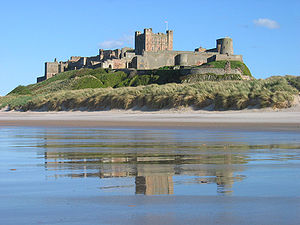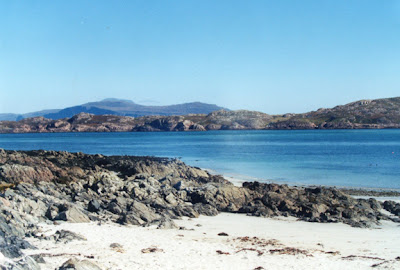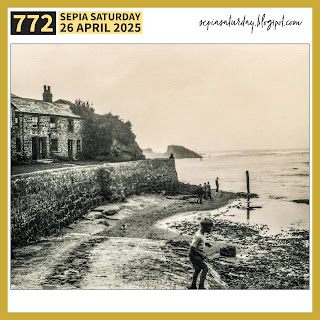This week's prompt photograph from Sepia Saturday features a rather bleak image of a lone figure staring out to sea from a rocky beach with a stone wall and a dilapidated house in the background.
I have hardly any
vintage beach scenes, so instead I am taking you (and my camera) on a coastal
journey across Scotland and the north of England, with ancient castles, lone figures, rocks and seascapes - many with a touch of history and also amily connections.

A ruined coastal castle in the Scottish town of St. Andrew's. Its university was founded in the 15th century, is Scotland's first university and the third oldest in the English speaking world. Before the Protestant Reformation in the 16th century, the castle served as the ecclesiastical centre for Scotland and witnessed several scenes of violence.
On the far right of the photograph is the prominent Bass Rock with its lighthouse and seabird colonies, but in the 1600s it was a remote prison. We had a clear view of it from our kitchen window and the bay was a favourite walk every day, with our dog enjoying clambering over the rocks.
The Bass Rock, off North Berwick in the Firth of Forth
The impressive rocky coast line at the fishing village of St. Abbs, Berwickshire in the Scottish Borders.
It was only much later when writing the narrative that it struck me I had no evidence whatsoever that the Samuel Donaldson born in 1728 in nearby Kirkbean, Dumfriesshire, was the same Samuel Donaldson who married in South Leith, in 1759. So I abandoned this line of research - but we enjoyed discovering a new part of Scotland!
Across the border into northern England
Until the 19th century, Blackpool was just a small hamlet. It rose to prominence with the building of the railway linking it to the mill towns of industrial Lancashire and Yorkshire and soon became England's most popular holiday resort, with its miles of golden sands. The unique Blackpool Illuminations were first switched on in 1879 to extend the season well into the autumn.
We move across country to South Shields on the north east coast of England, where my husband was born. Here is the beach at Marsden Rock where he enjoyed playing as a boy.

My daughter with her cousin, walking their dogs om Marsden beach.
Marsden Rock is a 100 foot sea stack which lies 100 yards off the cliff face. Believed to be once a smugglers' haunt, it is now the home of seabird colonies. In 1803 a flight of steps was constructed up the side of the rock. In 1903 several choirs climbed onto the rock to perform a choral service.

Here is Bamburgh beach in Northumberland
(a favourite day trip away), dominated by the impressive Bamburgh Castle
which can be seen for miles around. as it stasnds 150 feet above the North sea. Its history goes form Anglo Saxon Citadel to impenetrable Norman stronghold; home ome to a succession of kings from Henry VI to James 1 and the first
castle in the world to fall to gunpowder in the War of the Roses. Latterly home to the local Armstrong famiy.
As a child I remember having a book on heroines in history with an illustration of Grace Darling
(1815-1842), the lighthouse keeper's daughter at Bamburgh, who in 1838
risked storms and icy seas to rescue sailors from the shipwrecked
"Forfarshire. She died of consumption just four years later and is
buried in Bamburgh, with a museum dedicated to her life.
And lastly - one of my most favourite places - the Isle of Iona off the west coast of Scotland - a tiny island only 1-5 miles wide by 3 miles long, with a population of 120 permanent residents, famous as the home of St. Columba and the cradle of Scottish Christianity. It is a wonderful, magical place that is high on my "bucket list" to return.

My daughter a lone figure on the beach with the Isle of Mull in the background.
If you think it always rains in Scotland, think again when you see the
skies and seas in these photographs, though I admit we were very lucky
with the weather. We enjoyed exploring the island, walking south to
north and across to the west coast, looking onto the Atlantic - next stop North America!











Well Susan you've done it again! Taken me so many places I've only ever heard of, and a few I've never heard of, but my head is spinning that somehow I just went around the whole coast of Great Britain's island...I think. Indeed, these are great sunny looking pics! I'd certainly like to spend a while in many of those coastal towns. Thanks for the tour!
ReplyDeleteOh a big PS, Sue...there's a comment of yours on SS, but no link to this post. I'm glad I have your post showing in my list of favorites, so I got to read it.
ReplyDeleteBlame my impatience, Barbara - I got fed up forever checking that the Sepia Saturday link page had appeared, so published my post anyway. Then updated it with the link once the current SS page was there.
DeleteI really enjoyed your fantastic photos
ReplyDeleteGreat photos Sue. Who doesn’t like being by the sea?! I especially enjoyed your Mull photos. I think we stayed on the eastern side there, but in Lismore we were bent double by the wind!
ReplyDeleteThank you for sharing your memories of Mull. We stayed on the west of the island at Fionphort- just across from Iona - two magical islands
DeleteWonderful photos and a great 'end run' match to the prompt. Some of the sights in your photographs we saw on our 2015 trip to Scotland, but some were new to me and I wish I'd seen them back then in person such as the ruined castle at St. Andrews for one. When we came back in 2019, that tour included some places in England & I was hoping we'd have a chance to see the sign at the south end of mainland Britain as we'd seen & photographed the sign at the north end in 2015. Unfortunately the later tour didn't go that far south. Oh well.
ReplyDeleteThanks for the tour. I know I've been to St Andrews and to Land's End (on family holidays way back in the early 1970s), not sure about those places in between...
ReplyDeleteWhat a delightful post and beautiful photos of so many seasides and their landmarks. I love the finale signpost :-) Thanks also for our comment on my most recent blog post. You have such a rich family history, chronicled so well on your blog. Maybe you'd want to join me on the book journey to get some of your excellent writing into hard copy. We could blog about our experience along the way!
ReplyDeleteWow! You've certainly scoured all your photo albums and shoeboxes to assemble this tour de force. Britain's coastline is amazingly rugged and dramatic. And the most impressive thing is how, unlike America's seacoast, it is preserved from development (mostly) and linked with footpaths for all to enjoy freely.
ReplyDeleteFrom Scotsue - Thank you all so much for your lovely comments on my post. I was so pleased to read them and to share my photographs with you.
ReplyDelete